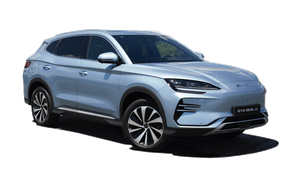Back when it made its debut, as one of the first real entries into the large electric van market, the eSprinter was deeply compromised. With its 55kWh battery, its total range was only 93 miles. With the latest generation, introduced in 2024, that has all changed. The battery has more than doubled in capacity and the range has pretty much tripled – from 93 miles to 271 miles on the WLTP test cycle, should you opt for the biggest battery pack.
On top of that, it retains a premium image and a quality feel, as with all Sprinters before it. The cabin features a lot of details found in Mercedes passenger cars, which is no bad thing, including the user-friendly MBUX interface. It’s an expensive van, but one with masses of appeal.
Range, Battery and Charging
The headline figure for the latest eSprinter applies to its 113kWh battery – an absolute monster in comparative terms. That’s the long-range option. An 81kWh battery with a 180-mile range is also available for those who don’t require as much distance per charge. There is also a choice of two motors, with either 135 or 204PS.
Three driving programmes are offered: Maximum Range, Economic and Comfort, controlling engine power, engine torque and climate control, while there are four regenerative braking settings, plus an ‘Auto’ function that determines the type of road you’re travelling on and adapts the regen accordingly – round town, almost to one-pedal driving, but with more coasting ability at higher speeds.
The Mercedes-Benz eSprinter is capable of both alternating current (AC) and direct current (DC) charging. On a DC fast charger, you can charge even the big battery from 10-80% in around 42 minutes, while an overnight charge using the onboard three-phase charger will take around nine hours. Overnight charging via a domestic supply will take almost double this, so you’ll need to plug it in the minute you get home if you want to use it for work the following day.
A lot of fleet operators, such as the major supermarket chains, use their own in-house DC charging to keep vans running for 18 hours a day.
Practicality, Payload and Dimensions
There are two body lengths on offer, L2 (long) or L3 (extra-long), two trim levels, PRO and SELECT, and a towing capacity of up to 1.5 tonnes, with a choice of body styles including conversion-ready chassis cabs and a panel van in two body lengths and one roof height.
In L3 form the panel van offers up to 14 cubic metres of cargo space, but in 113kWh form the Mercedes eSprinter is classified as having a 4.25-tonne gross vehicle weight. This means that anyone who passed their test after January 1, 1997, will need to have C1 entitlement on their licence or undertake an online assessment to get a 4.25t derogation. The 81kWh model remains classified at 3.5t so can be driven on a standard licence.
The load bay is practical and has LED lighting along the roof seams, with a vast array of panelling and racking options.
The load area measures 1787mm behind the rear wheel arches and 1200mm between them. The rear doors can be opened to the side walls even more easily and there is no longer a mechanically released catch in the 90-degree position, which means they can now be fully opened with one hand. The side sliding door opens a load aperture that is wide enough to accommodate a Euro pallet, too.
The van’s payload is the reason for the 4.25t classification – if the bigger battery van was classed at 3.5t then the payload would only be 745kg, similar to a Citroen e-Berlingo. Instead, it is 995kg, while the smaller battery model has a payload of up to 1,273kg.
Interior, Seating and Technology
With the latest eSprinter, the cabin isn’t massively different from before – but that’s no bad thing at all. Visually the model is identical to its predecessor, and aside from an updated MBUX touchscreen interface, which now integrates with smartphone mirroring via Bluetooth, the cabin remains largely unchanged. It’s still one of the smartest in the class.
The quality of the cabin is as good as ever, while that new generation of the MBUX multimedia system comes with a 10.25-inch colour display, telediagnostics and maintenance management, accident recovery and roadside assistance, remote vehicle locking and unlocking and pre-entry climate control, all operable via a connected app. There is also plenty of useful storage, with big door bins and multiple cup holders, along with A and C-type USB ports in the dash.
In order to preserve range, the heating system uses a heat pump, heated seats and active thermal management, while driver assistance and safety features include Active Brake Assist, Active Lane Keeping Assist, Blind Spot Assist, ATTENTION ASSIST drowsiness warning, Intelligent Speed Assist with cruise control, Mercedes-Benz emergency call system, an anti-theft protection package with a double-lock system and on panel van models, a reversing camera.
An parking package is also available, with a 360-degree camera and a 3D display for visibility of obstacles – unlike similar systems from Stellantis, this works very well, and it’s easy to predict distances when manoeuvring at low speeds.
Motors, Performance and Handling
You’re aware of the eSprinter’s weight from the get-go, as it feels heavy as soon as you climb into it and pull away – but despite that, it remains a pleasant and easy van to drive.
Like all electric vehicles, it’s simply a case of pressing the start button and engaging drive before you move off, although the electric parking brake feels a bit counterintuitive in that you pull it to release the brake and push it to engage it, rather than the other way around.
You select Drive by a small column stalk that’s a little too close to the wiper controls in our opinion, while there are three selectable driving modes - Comfort, Eco and Maximum Range. Comfort is the default setting, so if you want to see the full 271 miles of WLTP range then you need to engage Maximum Range separately, and drive it very sedately. That said, driven in Comfort, we saw a realistic real-world range of close to 200 miles in the big battery model, and that’s not bad at all.
You can also adjust the level of regenerative braking via the steering-wheel-mounted paddles. There are four modes - D-, D, D+ and D++. In D- you can slow the van to walking pace without touching the brake. If you don’t want to use the models manually then there is a new mode, called D Auto, which automatically adjusts the amount of regenerative braking to suit road conditions.
It handles well, with predictable roadholding despite its weight, while the electrically assisted power steering is well weighted. Visibility is impressive all-round despite the van’s size, especially when fitted with the aforementioned 360-degree cameras.
Running costs, Pricing and Specs
There are two trim levels on offer – PRO and SELECT. PRO is very much the fleet specification and can be optioned up from a very basic entry-level that seems pretty sparse for a vehicle with a £58,740 price tag (or £72,360 with the 113kWh battery), though the reality is that most of these will be heavily discounted large fleet deals. For the latest monthly offers on this or any other van, with free fast delivery, call our partner Vanaways on 0800 368 3286
All Mercedes eSprinters come with an integrated service package (ISP) as standard, which covers the costs of the first four services within the first four years, along with free, Europe-wide roadside assistance, including out-of-charge cover, for up to 30 years, as well as a three-year unlimited mileage warranty and an eight-year/100,000-mile battery capacity guarantee, extendable to 200,000 miles.
Verdict
The latest version of the Mercedes-Benz eSprinter is a fine van – arguably the best large electric van that you can buy. The downside, though, is that its quality is reflected in its pricing.
It may have jumped straight to the top of the segment, but that class-leading range and quality comes at a pretty hefty price, and if you’re less bothered about image and comfort, then the recently revised large electric vans from the Stellantis brands are far cheaper, albeit much less impressive to drive.



























